In Australia, you will see two kinds of people. A person, such as an elegant middle-aged couple leading a dog, a leisurely walk; In another case, a family travels, father pulls one in hand, mother hugs one, next to a big child pushing a small child in a cart, a family of six go together.
In Australia, either one is not born, or two or more. In China, although the two-child policy has been liberalized for two years, China's fertility rate is still poor.
In 2017, China's birth and fertility rates were 17.23 million and 12.43 per thousand respectively, according to the National Bureau of Statistics, both declining year-on-year, with births well below those predicted by the National Health and Family Planning Commission (figure below).

The < 2018 White Paper on the Wealth of the emerging Middle Class in China > shows that 47% of the people who meet the middle class standard have no children, and the proportion of people with only one child is basically balanced with that of the childless population, reaching 46%. Only 7% of people choose to have a second or third child.
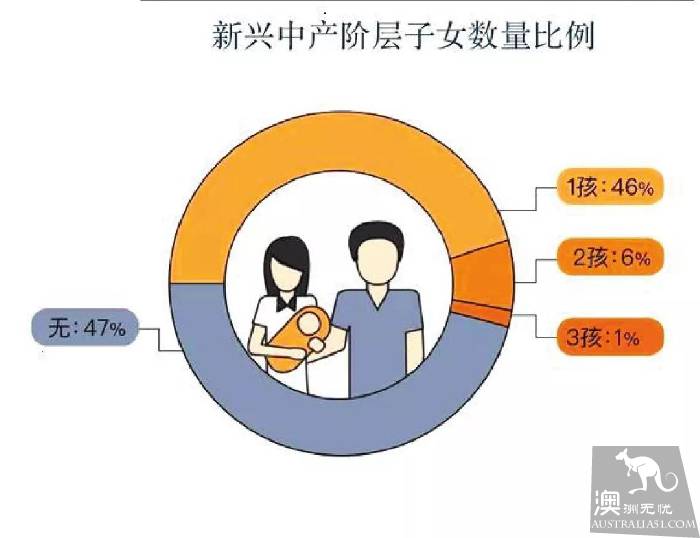
Why in China, even if the "two-child" policy is liberalized, people still choose not to have children, and in Australia, people tend to have three or four children?
1. Differences in the concept of parenting between China and Australia
"Chinese parenting model = baby-centered, family together."
For a long time in Australia, I have been asking this question: "Why is the Chinese a team with a child, an Australian is a single person with a regiment of children?"
Chinese baby a year and a half ago, grandpa, grandmother, babysitter, mother four full-time at home with children, husband home from work to help bring. The whole family is busy all day. This pattern is basically around the family of relatives and friends.
There are three main reasons:
1, one is that after the 80s in China, most of the novice parents of the post-90s generation are only children, and since childhood they have been interfered with more by their parents, and parents can't stand by and watch the other generation indulge their children and watch them cry to feed. Mischievous third generation, how can the elderly let go. 3 3 is in China, the consensus of the whole society is that children should take the young struggle career, the elderly or babysitter to take care of the children.
So the young parents smoothly put the primary responsibility for bringing up their children to their own parents.
"Australian parenting model = Australian mom, independent Australian dad, volunteering to help children take care of their children."
When Australians marry, parents will never move in with their children, let alone help look after their children like Chinese grandparents. Weekend or the child is ill, see a day or two can, not for a long time. They would rather retire and travel all over the country. The children have been taken care of by their young parents since their infancy.
And Australians are used to being independent when they are young, and the things they can solve are basically not dependent on their parents, so many Australian women have developed the habit of being alone. Plus in Australia, 80% of young dads take the initiative to act as dads, from feeding, bathing, coaxing to school, and Australian dads do everything in their own right.

In addition, in the Australian family's parenting model, older children tend to shoulder the responsibility of taking care of their younger brothers and sisters, much like the older generation in China.
"an independent and all-powerful Australian mother, an Australian father who offered to help, and a child to take care of the children, so it's not a big deal to have two or three children in Australia.
In contrast, in China, most grandparents help to bring up children, the new father in front of his parents, especially unaware of his responsibility as a father. Similarly, if there are grandparents, the new mother will be particularly dependent on their parents. Finally, the young man himself was unwilling and had no time to take care of the children. As their elderly parents get older, they become less able to take care of their children, so don't say two children, even raising a child can make the whole family feel tired and tired. "
2. Working in Australia is the same "economic benefit" as taking kids at home.
The Australian Family, income and Employment Dynamics Research Group followed up 9500 Australian households (more than 17000 respondents). Child care costs in Australia have soared in recent years, and under-five child care costs have risen significantly, according to the agency's report. The cost of childcare for two-parent families rose 75 percent compared to 2002, while that for single-parent families rose 104 percent.
Rising childcare costs have deterred many Australian parents. Make money, send children to the class for others to take care of, it is better to take care of themselves at home.
So, if the husband's income is enough to cover family expenses, Australian women will choose to be a full-time mother and take care of their children. Especially in Australia's private schools, the vast majority of mothers are full-time mothers. In Australia's values, the status of "full-time mother" has been widely accepted by the community as a whole, which has also accelerated the Australian two-child and three-child process to some extent.
3. Chinese children are much more expensive than Australia.
Australia: average cost A $ eight hundred and twelve thousand
The cost of raising Children in Australia report 2016 shows that in Australia, middle-income families spend an average of eight hundred and twelve thousand Australian dollars (about 3.8 million yuan) on average, taking raising two children from birth to the leave family as a measure of self-reliance. Low-income households spend an average of four hundred and seventy three thousand nine hundred and ninety nine Australian dollars (2.22 million yuan), while high-income families spend as much as 1.09 million Australian dollars (5.12 million yuan) on parenting.
China: average cost at least 50-1.5 million RMB
In China, by contrast, it will cost at least five hundred thousand yuan to raise a child to graduate from college, despite future inflation in prices and education costs. The following figure gives a clear breakdown of the costs parents need to pay in the process of their child's success.
However, the total of nearly five hundred thousand yuan account list, at best, can only be a moderate basic level. In fact, there are many possible links that are not included, such as going abroad for further studies in one hundred thousand to eight hundred thousand, and buying 3 million school district rooms (without capping the top).
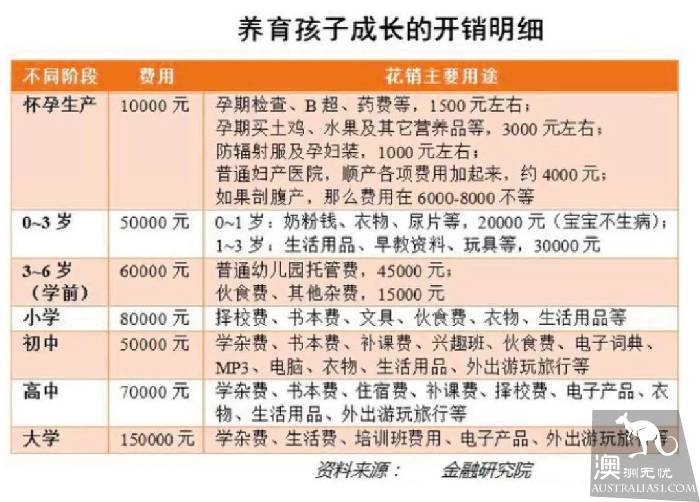
If all is converted to RMB, the average cost looks higher in Australia. But if income factors are taken into account, the results may be completely different.
Australia's annual income per capita in 2017 was A $81,746, up 1.8 percent from 2016, according to data. In 2017, China's per capita annual income was 55,411 yuan. If the maintenance period is set at 22 years, spending on children accounts for 1.75 times as much of Chinese personal income as Australians.
Excluding the exchange rate, the burden of parenting in China is much heavier than that of Australians.
Under the pressure of all kinds of expenses, the Chinese are more and more afraid to have children. Some even say that in China, having a child is like giving up a chance to become a millionaire. There are many young couples joked: "raising children is better to raise frogs."

4. A sound maternal and child health care system
In addition to parenting and economic perspectives, a good maternal and child health system is another reason why Australians have more children.
To ensure maternal and infant health, Australia's government has established a sound maternal and child health care system. As soon as women become pregnant, local medical institutions have specialized organizations for pregnant women to participate in free maternal health care and training on how to give birth.
In the case of caesarean section, the mother can usually stay in a single ward, usually two in one ward. Family members do not need to spend the night, nurse will take care of the pregnant women 24 hours. For the first month after discharge, district doctors and nurse will visit mothers and babies free of charge every week to ensure the safety of the mother and child.
In Australia, not only are mothers taken care of, fathers can also enjoy the benefits of newborn babies. If a family is under pressure to give birth to a new child and the father applies for unpaid leave, he can receive $672.60 a week (pre-tax) allowance, but only two weeks' leave at most.
5. Comprehensive childcare benefits and services
Child Care Subsidy (child care allowance)
Over the next four years, Australia's government plans to invest an additional A $2.5 billion to support 1.2 million families with childcare services. This will help more Australian families in need of help, reduce the burden of family care, and make it easy to raise children and even worry about them.
Australia's government provides financial assistance to families, known as child care subsidy (Child Care Subsidy).), mainly through two policies: child care benefit (Child Care Benefit) and child care fee refund (Child Care Rebate).
Childcare benefits (Child Care Benefit) needs to be based on family income, but child-care refund (Child Care Rebate) does not need to pass an income review.

1, child care allowance standard
In terms of the amount, households earning A $65710 or less will receive 85 percent of the actual cost subsidy, as shown in the figure below.
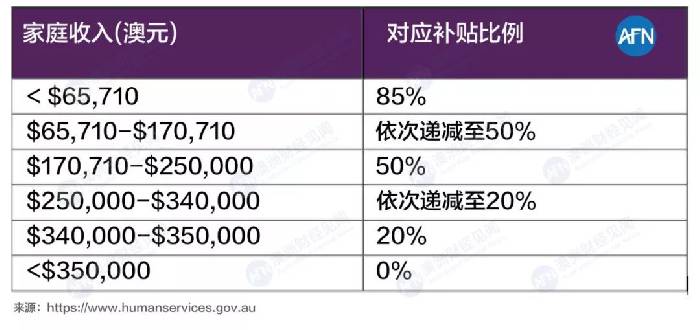
(* the new list will be enabled from July 2018 and the data will be adjusted accordingly according to CPI.)
When personal income increases from A $65710 to A $ three hundred and forty thousand, subsidies gradually decline to 20%. For households earning A $ three hundred and fifty thousand or more, the subsidy is zero. Typically, for every A $3000 increase in income, the subsidy is reduced by 1 percent for a single household eligible for the subsidy.

2, qualification test
With the exception of household income as a criterion, whether a family is eligible for childcare benefits by the hour will require a three-step test to determine whether or not a family is eligible for childcare benefits. Eventually, the number of childcare hours obtained matches the work of a family, studies, or the time they take part in public welfare activities, providing up to 100 hours of childcare allowance every two weeks.
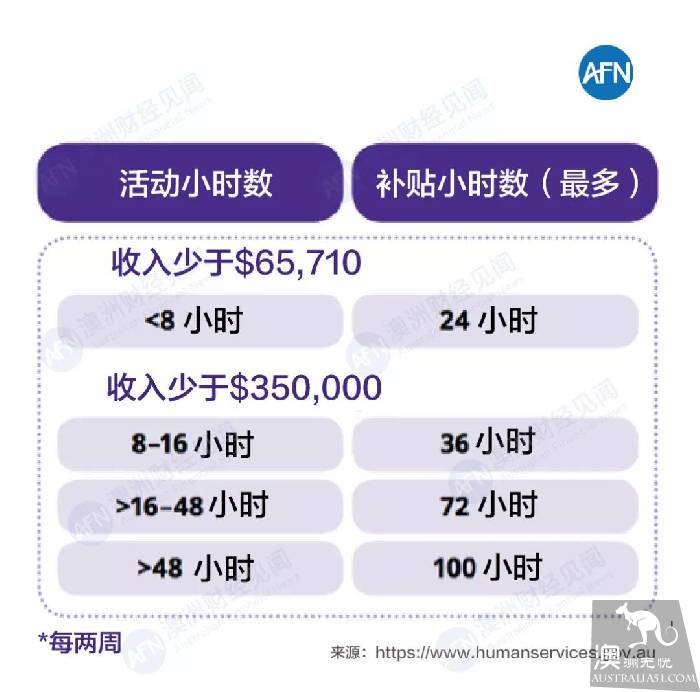
The longer the number of hours of social activities, the more hours of child care allowance. Recognized social activities include:
- paid work
- Learning and training
- Unpaid family business
- Voluntary service
- [财]self employment
- othe
Low-income households earning less than A $65710 or less a year will receive a 24-hour twoweek childcare subsidy without having to meet the test.
After looking at the above introduction, you may still feel in the fog, do not know exactly how the hourly qualification test works, look at this example, may help you.
Stories around you-extra childcare allowance
Australian Natasha (Natasha) currently has no job and is studying at a full-time university to increase her chances of future employment. Her two-year-old daughter attends the local long-day childcare centre (long-day care center) 10 hours a day) 5 days a week. Long-day childcare centres charge A $78.50 a day, or A $392.50 a week. By July 2018, the cost will be A $92.44 per day or A $462.20 per week.
As Natasha is in the transition from study to work, she will be eligible for additional childcare allowance (Additional Child Care Subsidy).
Since the aid was tested by the campaign, (activity test). With 49 or more hours of study every two weeks, Natasha gets 50 hours of childcare a week. Eventually, Natasha will receive a subsidy of up to 95 percent of childcare costs, leaving only 5 percent of her own expenses (A $4.62 a day or A $23.11 a week).
6. Other types of childcare benefits
1, newborn allowance
Neonatal subsidy (Newborn Supplement) is a short-term grant for newborns to ease the financial pressure of newborn parents. From the start of pregnancy, a maximum of 13-week benefits are available, with a maximum benefit of A $1618.89 for the first child and A $540.54 for subsequent births.
2, paid maternity leave
Paid maternity leave is offered to working newborn parents. This benefit is available if the newborn leaves because of the need to take care of the baby. Parents are entitled to $695 a week (pre-tax), up to 18 weeks. Choose one of two with newborn allowance.
3. Parental benefits
Such benefits are provided to parents who need to raise their children and who are poorer, and are entitled to parental benefits up to the age of 18.
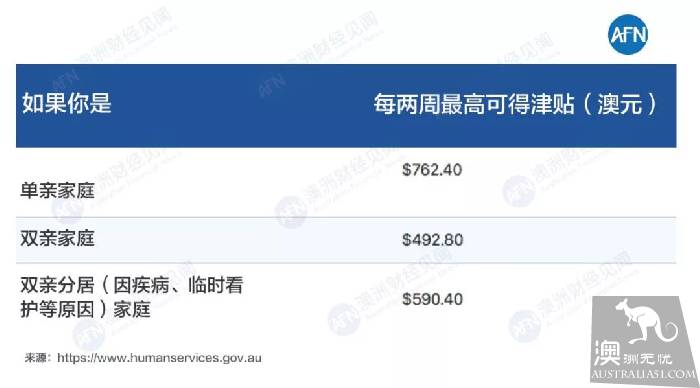
4. Family tax benefits
Australia has a family tax benefit called (Family Tax Benefit), Family Grant FTB, a part A that basically applies to all families, including milk benefits, low-income subsidies, rent subsidies, etc., which is a long-term benefit for families provided by the Australian government.
Calculate the benefits based on family income, children's age and the number of children.
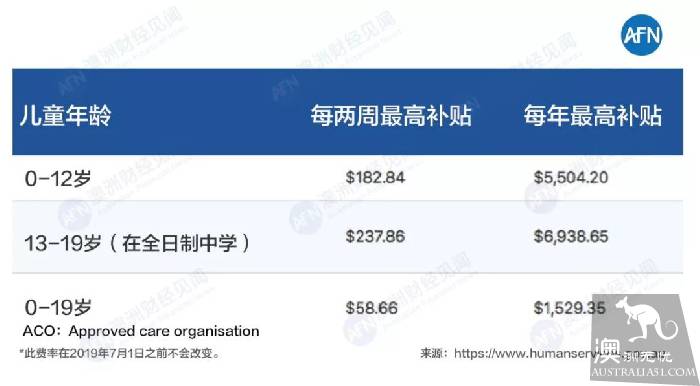
FTB's part B claims are higher and apply to single-parent families, one of whom is unemployed or a low-income family. But whether it's part A or part B, the less you earn, the more children you get, and the more subsidies you get.
Note: policy or price changes from time to time, please refer to the government website:
https://www.humanservices.gov.au/individuals/enablers/payment-rates-family-tax-benefit-part-b
END
Not long ago, an exploding frog-raising game scoured the screen in many people's Time line, and it is said that people can experience the feeling of being a parent through the process of raising frogs.
Raising frogs is simple. All you have to do is watch it travel around the world, read and write, make friends, sleep, never misbehave and disappear. Even traveling around the world sends postcards to you from all over the world.
Raising a child is a big deal, not to mention that it takes a lot of effort and effort to be a parent, and that the cost of raising a child is enough to discourage millions of people.
However, in Australia, the concept of "stocking" parenting, a sound maternal and child health care system, a variety of family welfare allowances, a powerful medical system, no wonder Australians think that raising children and frogs, that is not a matter! At present, more and more Chinese pregnant women also go on a long way to come to Australia to have children with a big belly.
Reference:
https://www.humanservices.gov.au
https://www.mychild.gov.au
https://www.education.gov.au
http:// www.humanservices.gov.au
http:// australia.gov.au/topics/benefits-payments-and-services/family-payments-and-services
https://www.humanservices.gov.au/individuals/enablers/payment-rates-newborn-upfront-payment-and-newborn-supplement
https://www.humanservices.gov.au/individuals/enablers/payment-rates-family-tax-benefit-part